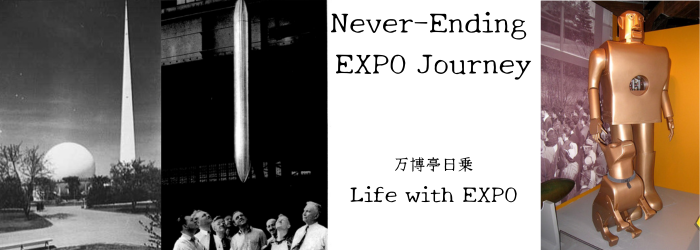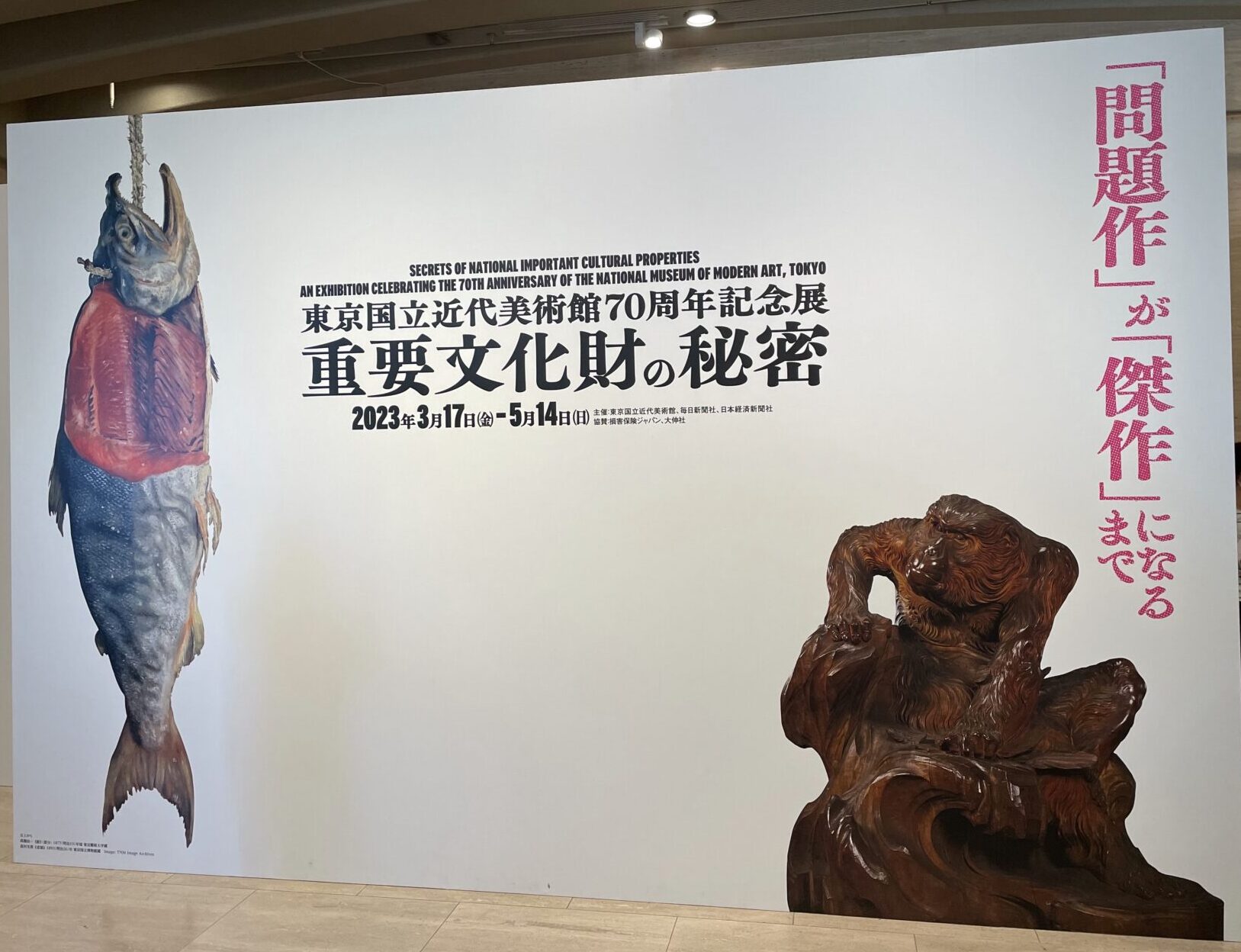“Secrets of National Important Cultural Properties”
I went to the National Museum of Modern Art, Tokyo in Takebashi, Tokyo, where an exhibition titled “Secrets of National Important Cultural Properties” was being held.
It is titled “An Exhibition Celebrating The 70th Anniversary of The National Museum of Modern Art, Tokyo”.
Celebrating The 70th Anniversary of The National Museum of Modern Art, Tokyo
Secrets of National Important Cultural Properties
March 17 – May 14, 2023
The National Museum of Modern Art, Tokyo
Organized by:
The National Museum of Modern Art, Tokyo
Mainichi Newspaper Company
Nikkei Inc.
Sponsored by:
Sompo Japan Insurance
Daishinsha
The title of this exhibition is “Secrets of National Important Cultural Properties”, and it means that all the works on display (because it is a museum of modern art, they were produced after the Meiji period) are designated as National Important Cultural Properties. It is a very exciting exhibition.

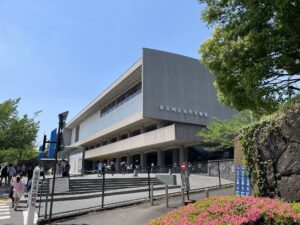
Mr. Shogo Otani’s essay at the beginning of the catalog begins with the sentence, “To be honest, this is a venturesome exhibition.”
It would be possible to simply collect and display the items owned by one’s own museum, but it would be difficult to negotiate with the various owners to rent items that are scattered all over Japan.
For each owner, a ‘National Important Cultural Property’ is the “selling point” of each museum, and lending it out means that the “star works” of the holding museum are absent during that time.
However, in fact, as it is being held now, the project came to fruition.
Of the 68 works (paintings, sculptures, and crafts) created after the Meiji era that have been designated as National Important Cultural Properties, this exhibition brings together 51 of them.
In 1950, the Law for the Protection of Cultural Properties was promulgated to define “National Important Cultural Properties.”
This exhibition focuses on the keyword “National Important Cultural Property” and tries to clarify when each work was designated as a “National Important Cultural Property” and why.
Therefore, in the caption next to each work, there is a commentary that says “designated as an National Important Cultural Property in the year of ○○”.
For example, the first work to be designated after the Meiji era was in 1955, and there were four works. These works are Hogai Kano’s “Fudo Myoo Zu (Acalanatha)”, “Hibo Kannon (Avalokitesvara as a Merciful Mother)”, Gaho Hashimoto’s “Hakubai Koju (White Clouds and Autumn Leaves)”, and “Ryuko Zu Byobu (Dragon and Tiger)”.
Following this, various works were designated as “National Important Cultural Properties”.
Indeed, if you study this hard, you can understand the flow of Japanese modern art works after the Meiji era and how they were evaluated. The catalogue of this exhibition is also a masterpiece with very detailed explanations.
World Expos and Japanese Modern Art
However, of course, the main purpose of my visit this time is to find out the relationship between Japanese modern arts and World Expos.
According to my review of the captions of the exhibition and catalog, the following works (which are exhibited at this exhibition) were exhibited at World Expo.
Again, this time, the focus is on exhibits at the 1893 Chicago World’s Fair (Chicago World’s Columbian Exposition 1893).
Koun Takamura, “Old Monkey”(1893)
Designated as a National Important Cultural Property in 1999.
Exhibited at the 1893 Chicago World’s Fair.
Kozan Miyagawa I, “Ouyu Sabiebai Juzu Taihei ( a Large V with a Plum Tree)” (1892)
Designated as a National Important Cultural Property in 2004.
Exhibited at the 1893 Chicago World’s Fair.
Yohei Seifu III, “White porcelain butterfly peony floating design large bottle” (1892)
Designated as a National Important Cultural Property in 2017.
Exhibited at the 1893 Chicago World’s Fair.
Chokichi Suzuki, “Eagle Figurine” (1892)
Designated as a National Important Cultural Property in 2001.
Exhibited at the 1893 Chicago World’s Fair.
Chokichi Suzuki, “Twelve Hawks” (1893)
Designated as a National Important Cultural Property in 2019.
Exhibited at the 1893 Chicago World’s Fair.
Sosuke Namikawa, “Cloisonne Fugaku Picture Frame” (1893)
Designated as a National Important Cultural Property in 2011.
Exhibited at the 1893 Chicago World’s Fair.
As I wrote before, from 2004 to 2005, the exhibition
“Commemorating The 2005 World Exposition, Aichi, Japan
Arts of East and West from World Expositions”
was held at the Tokyo National Museum, the Osaka City Museum of Art, and the Nagoya City Museum. And I was also involved as part of my work.
In fact, all of the works mentioned above were exhibited at that exhibition.
So, this time was the first time in 18 years to see these works again.
All of them were exhibited at the 1893 Chicago World’s Fair.
As I wrote before, the Tokyo National Museum owns many other works that were exhibited at the 1893 Chicago World’s Fair.
Although it was not exhibited at World Expos, Kozan Miyagawa I’s “Footed Bowl with Crabs “ (1881) was exhibited this time.
This “Footed Bowl with Crabs ” was exhibited at the 2nd National Industrial Exhibition of Japan.
It was designated as a National Important Cultural Property in 2002.
The first time I saw this work was at the exhibition of 2004″Arts of East and West from World Expositions”.
Once you see this work, you will never forget it. It is a work in which very realistic crabs are attached to a bowl (and two of them overlap). At first, the crabs look so real that I thought they were real crabs attached.
I was able to reunite with this work after a long time.
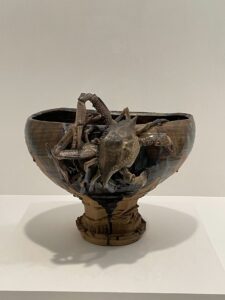
初代宮川香山『褐釉蟹貼付台付鉢』、東京国立博物館 #重要文化財の秘密
Miyagawa Kozan I, Footed Bowl with Crabs, Tokyo National Museum
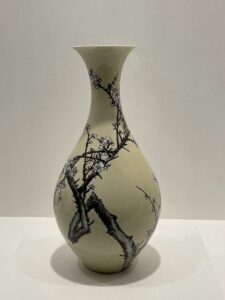
初代宮川香山『黄釉銹絵梅樹図大瓶』、東京国立博物館 #重要文化財の秘密
Miyagawa Kozan I, Large Vase with a Plum Tree, Tokyo National Museum
By the way, the 1893 Chicago World’s Fair was not the first time Kozan Miyagawa I participated in the World Expo. According to the catalogue this time, he exhibited ‘Kabin Koro Shichifukujin no Soshoku’ at 1876 Philadelphia World Exposition. And after that, he won a Gold Medal at the 1878 Paris Exposition.
And, Emile Gallé (1846-1904), who is famous for his art nouveau glass works and was active in various international expositions, had a collection of Kozan Miyagawa’s four-legged bowl “Koi“. This work has a drawing of three carps on its side, and Gallé created works with this as a motif.
I notice that many of these works have been designated as National Important Cultural Properties only recently. It is said that recent advances in research on World Expos have led to the works being highly evaluated, leading to their designation as National Important Cultural Properties.
“Twelve Hawks” produced by Tadamasa Hayashi
Chokichi Suzuki’s Twelve Hawks, exhibited at the Chicago World’s Fair in 1893, is also an unforgettable piece that was designated as a National Important Cultural Property in 2019. Just before the Covid-19 pandemic. In other words, when it was exhibited at the exhibition of 2004 ‘Arts of East and West from World Expositions’, it had not yet been designated a National Important Cultural Property.
This work was conceived and produced by Tadamasa Hayashi, an art dealer who traveled to Paris as an interpreter for the Kiriu Kosho Kuwaisha (The First Japanese Manufacturing and Trading Company) on the occasion of the 1878 Paris World Exposition. According to the explanation in this catalog, it says;
*
Hayashi Tadamasa, an art dealer, devised a three-dimensional reproduction of a falconry ritual in metal for the 1893 Chicago Columbus World’s Fair. Suzuki Chokichi, a metal casting expert who had gained fame at overseas expositions as the head of the copper foundry of the Kiriu Kosho Kaisha, was appointed as overall commander, and a total of 24 craftsman from various fields were assembled to produce this work. .
*
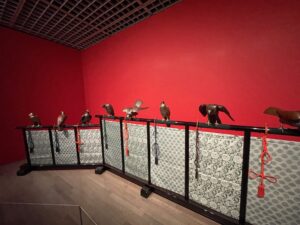
鈴木長吉『十二の鷹』、国立工芸館 #重要文化財の秘密
Suzuki Chokichi, Twelve Hawks, National Crafts Museum
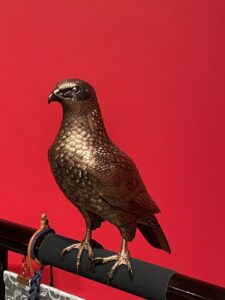
鈴木長吉『十二の鷹』、国立工芸館 #重要文化財の秘密
Suzuki Chokichi, Twelve Hawks, National Crafts Museum
I must be probably the only one who wonders if there was a “goshawk” among them, that triggered the change of the venue of “EXPO 2005 AICHI, JAPAN” more than 100 years later…
At the 1893 Chicago World’s Fair, the Japanese side seems to have made considerable efforts to have their crafts recognized as “art” and displayed in “Art Pavilion.”
“The Twelve Hawks” was one of the works that received the highest acclaim at the 1893 Chicago World’s Fair. . According to the catalog of the 2004 exhibition “Arts of East and West from World Expositions” (page 99), it says as follows;
“In the two-big-volume《THE BOOK OF THE FAIR》documenting the Chicago Expo, this work (“The Twelve Hawks”) is mentioned in the descriptions of each of the Art Pavilion and Craft Pavilion. The part of the book having the image of the second floor of the venue (which was Craft Pavilion) does not show “The Twelve Hawks”.
From this fact, this work was initially exhibited in the Craft Pavilion, but after the Japanese section of the Art Pavilion was expanded, it was moved to the Art Pavilion.”
And in the catalog of the “Secrets of National Important Cultural Property” exhibition, a more detailed explanation is written on page 243. Research must have progressed in the last 20 years or so.
Seiki Kuroda and the 1900 Paris World Exposition
By the way, Seiki Kuroda’s “Lakeside” is also exhibited this time.
Seiki Kuroda “Lakeside” (1897)
Designated as a National Important Cultural Property in 1999.
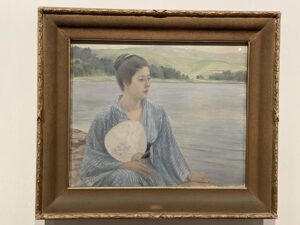
黒田清輝『湖畔』、東京国立博物館 #重要文化財の秘密
Kuroda Seiki, Lakeside, Tokyo National Museum
For some reason, the relationship between this work and the World Exposition is not mentioned in the catalog or the explanation of the exhibition, but this work was actually exhibited at the Paris Exposition of 1900.
This “Lakeside” is probably one of Seiki Kuroda’s most famous works. It was also used for a postal stamp, and I first learned about it from this stamp when I was a child.
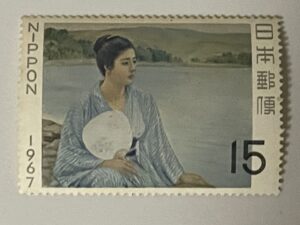
『湖畔』切手
This work was exhibited at the 1900 Paris World Exposition, and Kuroda exhibited a total of four works at the same Paris Exposition including “Lakeside”.
Among them, “Wisdom, Impression, Sentiment” (at that time, it was titled “Etude de Femme“) was the most highly evaluated and won the Silver Prize.
“Wisdom, Impression, Sentiment” is in the collection of the Tokyo National Museum (Kuroda Memorial Hall), and was also exhibited at the 2004 exhibition “Arts of East and West from World Expositions”
(this work is not exhibited this time).
This work was made in 1899, designated as a National Important Cultural Property in 2000, and exhibited at the 1900 Paris World Exposition.
This is a fairly large work, with full-length figures of three naked women drawn side by side.
It is a work with a unique atmosphere that expresses “Wisdom”, “Impression”, and “Sentiment” from the right.
Speaking of the 1900 Paris World Exposition, it was also the Exposiiton where the 1892 work “The Sleeping (Le Sommeil)” by the French painter Raphaël Collin (1850-1916), who Seiki Kuroda studied under, was exhibited.
At the Pola Museum of Art in Hakone, the following exhibition was held from 2020 to 2021.
150 YEARS OF MODERN ART IN JAPAN AND FRANCE
Longing beyond the sea, 150 years of Japan and France
(Organizer: Pola Art Foundation, Pola Museum of Art)
The “Foreword” in this catalog reads as follows:
*
・・・The painting Sleep (1892) by Raphaël Collin (1850 -1916) that was seen by Kuroda Seiki at the 1900 Paris Universal Exposition is being shown to the public for the first time in 120 years. This work greatly influenced Kuroda’s highly regarded painting The Fields (1907). The direct encounter of the two paintings has long been awaited.
*
In fact, Collin’s “Sleep / The Sleeping (Le Sommeil)”, which was exhibited at the 1900 Paris Exposition, and Kuroda’s “The Fields”, are very similar. “Nobe (The Fields )” is slightly smaller in size, but when you look at these two works, you can feel Kuroda’s homage to Collin.
Chu Asai and the 1900 Paris Exposition
In fact, this time, Chu Asai‘s “Shunpo (Vegetable Garden in Spring)” (1888, designated as a National Important Cultural Property in 1970) and “Shukaku (Harvest)” (1890, designated as a National Important Cultural Property in 1967) were also exhibited.

浅井忠『収穫』、東京藝術大学 #重要文化財の秘密
Asai Chu, Harvest, Tokyo University of the Art
There is no explanation that these works were exhibited at the World Exposition, but Chu Asai himself was dispatched to Paris for the 1900 World Exposition as a ” temporary administrative staff” of the “Temporary Secretariat for the 1900 Paris World Exposition of Japan.“
The “Report of the Temporary Secretariat for the 1900 Paris World Exposition,” states the following:
*
In addition to that, we assigned …, Chu Asai, … and dispatch him to Paris to handle administrative affairs with the three architects “Charles Réguier”, “Jacques Petitgrand”, and “Raphaëlguy”. . (I’m not sure the spellings of these names…)
*
It is understood that Chu Asai, who was studying in Paris, was involved in the operations of the Japan Exhibition of the Paris Expo together with foreign architectural engineers as a “temporary administrative staff”.
Soseki Natsume and the 1900 Paris World Exposition
By the way, Soseki Natsume also stopped by at the Paris World Exposition in 1900.
He stopped in Paris on his way to London to study there.
According to Chiba Prefectural Museum of Art’s “Chu Asai in Paris”, Soseki Natsume and Chu Asai had a close relationship, and when Soseki went to Paris in October (during the 1900 Paris World Exposition period), he stayed at the inn in Malakoff where Chu Asai was living.
Also, when Asai returned to Japan, on his way back to Japan, he stopped by in London, stayed at Soseki’s inn, walked around the city together, and ate at some restaurants together. And Asai is the model for Fukami, the painter who appears in Soseki’s “Sanshiro“, and Asai did the illustrations for the middle and second volumes of “I am a cat”.
Soseki was a person who was also very interested in art, so he probably had a close relationship with Asai.
Soseki wrote the following in a letter addressed to his home on October 23, 1900, when he went to the Paris Exposition.
*
Today, we went to Paris World Exposition. Everything was very huge and it was very difficult to know even where I was in the huge venue. I went up to the famous Eiffel Tower and looked around the city from the top. This tower is 300 meters high and we were put into a box and were drawn up and down between the top and bottom of the tower. The Exposition is so huge that I can’t make out the whole picture with just 10 or 15 days. (Translated by the author)
*
Soseki also did climb the Eiffel Tower built by Gustave Eiffel for the 1889 Paris World Exposition at the time of the 1900 Paris World Exposition.
Around the time of the 1900 Paris World Exposition, many Japanese people we know, such as Tadamasa Hayashi, Seiki Kuroda, Chu Asai, Soseki Natsume, Otojiro & Sadayakko Kawakami, and Kokichi Mikimoto, went to the venue or World Exposition, or were related to the World Exposition.
Well, this time I’ve been talking all about the Expo, but of course, there are many masterpieces in this exhibition that I passed by this time.
However, I think that enjoying the exhibition, focused on the theme of the World Expo is definitely one way to enjoy it!
